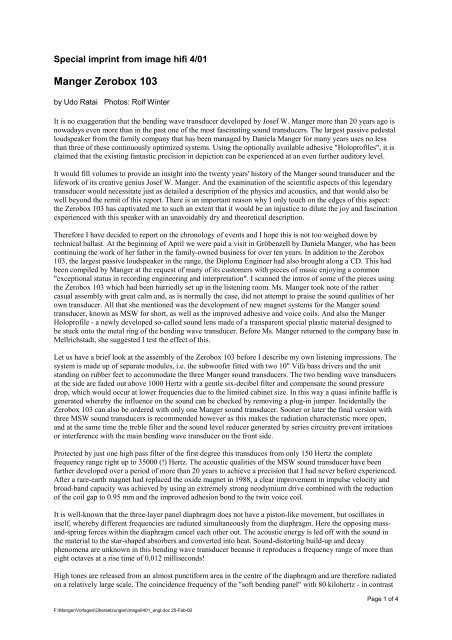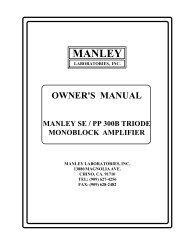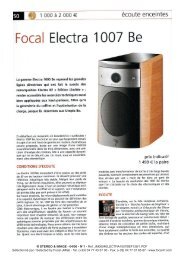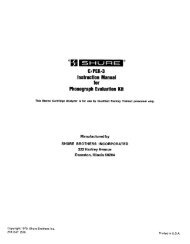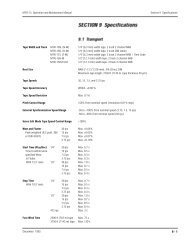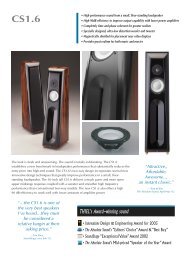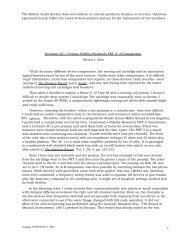Manger Zerobox 103 - AllegroSound
Manger Zerobox 103 - AllegroSound
Manger Zerobox 103 - AllegroSound
Create successful ePaper yourself
Turn your PDF publications into a flip-book with our unique Google optimized e-Paper software.
Special imprint from image hifi 4/01<br />
<strong>Manger</strong> <strong>Zerobox</strong> <strong>103</strong><br />
by Udo Ratai Photos: Rolf Winter<br />
It is no exaggeration that the bending wave transducer developed by Josef W. <strong>Manger</strong> more than 20 years ago is<br />
nowadays even more than in the past one of the most fascinating sound transducers. The largest passive pedestal<br />
loudspeaker from the family company that has been managed by Daniela <strong>Manger</strong> for many years uses no less<br />
than three of these continuously optimized systems. Using the optionally available adhesive "Holoprofiles", it is<br />
claimed that the existing fantastic precision in depiction can be experienced at an even further auditory level.<br />
It would fill volumes to provide an insight into the twenty years' history of the <strong>Manger</strong> sound transducer and the<br />
lifework of its creative genius Josef W. <strong>Manger</strong>. And the examination of the scientific aspects of this legendary<br />
transducer would necessitate just as detailed a description of the physics and acoustics, and that would also be<br />
well beyond the remit of this report. There is an important reason why I only touch on the edges of this aspect:<br />
the <strong>Zerobox</strong> <strong>103</strong> has captivated me to such an extent that it would be an injustice to dilute the joy and fascination<br />
experienced with this speaker with an unavoidably dry and theoretical description.<br />
Therefore I have decided to report on the chronology of events and I hope this is not too weighed down by<br />
technical ballast. At the beginning of April we were paid a visit in Gröbenzell by Daniela <strong>Manger</strong>, who has been<br />
continuing the work of her father in the family-owned business for over ten years. In addition to the <strong>Zerobox</strong><br />
<strong>103</strong>, the largest passive loudspeaker in the range, the Diploma Engineer had also brought along a CD. This had<br />
been compiled by <strong>Manger</strong> at the request of many of its customers with pieces of music enjoying a common<br />
"exceptional status in recording engineering and interpretation". I scanned the intros of some of the pieces using<br />
the <strong>Zerobox</strong> <strong>103</strong> which had been hurriedly set up in the listening room. Ms. <strong>Manger</strong> took note of the rather<br />
casual assembly with great calm and, as is normally the case, did not attempt to praise the sound qualities of her<br />
own transducer. All that she mentioned was the development of new magnet systems for the <strong>Manger</strong> sound<br />
transducer, known as MSW for short, as well as the improved adhesive and voice coils. And also the <strong>Manger</strong><br />
Holoprofile - a newly developed so-called sound lens made of a transparent special plastic material designed to<br />
be stuck onto the metal ring of the bending wave transducer. Before Ms. <strong>Manger</strong> returned to the company base in<br />
Mellrichstadt, she suggested I test the effect of this.<br />
Let us have a brief look at the assembly of the <strong>Zerobox</strong> <strong>103</strong> before I describe my own listening impressions. The<br />
system is made up of separate modules, i.e. the subwoofer fitted with two 10" Vifa bass drivers and the unit<br />
standing on rubber feet to accommodate the three <strong>Manger</strong> sound transducers. The two bending wave transducers<br />
at the side are faded out above 1000 Hertz with a gentle six-decibel filter and compensate the sound pressure<br />
drop, which would occur at lower frequencies due to the limited cabinet size. In this way a quasi infinite baffle is<br />
generated whereby the influence on the sound can be checked by removing a plug-in jumper. Incidentally the<br />
<strong>Zerobox</strong> <strong>103</strong> can also be ordered with only one <strong>Manger</strong> sound transducer. Sooner or later the final version with<br />
three MSW sound transducers is recommended however as this makes the radiation characteristic more open,<br />
and at the same time the treble filter and the sound level reducer generated by series circuitry prevent irritations<br />
or interference with the main bending wave transducer on the front side.<br />
Protected by just one high pass filter of the first degree this transduces from only 150 Hertz the complete<br />
frequency range right up to 35000 (!) Hertz. The acoustic qualities of the MSW sound transducer have been<br />
further developed over a period of more than 20 years to achieve a precision that I had never before experienced.<br />
After a rare-earth magnet had replaced the oxide magnet in 1988, a clear improvement in impulse velocity and<br />
broad-band capacity was achieved by using an extremely strong neodymium drive combined with the reduction<br />
of the coil gap to 0.95 mm and the improved adhesion bond to the twin voice coil.<br />
It is well-known that the three-layer panel diaphragm does not have a piston-like movement, but oscillates in<br />
itself, whereby different frequencies are radiated simultaneously from the diaphragm. Here the opposing massand-spring<br />
forces within the diaphragm cancel each other out. The acoustic energy is led off with the sound in<br />
the material to the star-shaped absorbers and converted into heat. Sound-distorting build-up and decay<br />
phenomena are unknown in this bending wave transducer because it reproduces a frequency range of more than<br />
eight octaves at a rise time of 0.012 milliseconds!<br />
High tones are released from an almost punctiform area in the centre of the diaphragm and are therefore radiated<br />
on a relatively large scale. The coincidence frequency of the "soft bending panel" with 80 kilohertz - in contrast<br />
F:\<strong>Manger</strong>\Vorlagen\Übersetzungen\image0401_engl.doc 20-Feb-02<br />
Page 1 of 4
with the "rigid bending transducers" such as NXT, Walsh or DDD drivers - is also well outside of the audible<br />
range. At low frequencies on the other hand a transition to approximately piston-like movement takes place,<br />
whereby + 3,5 millimetres stroke and a thermally high-load voice coil weighing only 0.4 grams ensure sound<br />
pressure reserves in excess of 120 decibels. The occasional prejudices, which the <strong>Manger</strong> sound transducer is<br />
still confronted with, completely disappear into thin air as we discovered later. However the complex assembly<br />
of the driver prevents an automation of the manufacturing process, which explains the high price for the bending<br />
wave transducer, which is available separately.<br />
Traditionally Josef <strong>Manger</strong> combines his extremely phase-linear MSW in the bass range using bass units that are<br />
installed airtight, and optimized for a low Q factor and therefore for a fast and overshoot-free response. Special<br />
units by Vifa with rigid paper/carbon fibre diaphragm together with frequency cross-over with so-called zero<br />
ohm transformer coils are used for this.<br />
Returning to my initial impressions gathered in this magazine's own listening studio using the CD sampler<br />
available directly from <strong>Manger</strong>. The first track isn't really music as such, but an example of sound - namely the<br />
full peal of bells from the bell-tower of a church in Gütersloh. Anyone who can't hear the temporal precision and<br />
dynamics of the clapper strikes within a matter of milliseconds is either deaf or has only ever heard the world as<br />
an acoustically distorted recording. No loudspeaker sound, no individually audible loudspeaker clouds the<br />
illusion that you are sitting right in the middle of the bell-tower. The unbelievable energy and crystalline purity<br />
in the topmost treble range, combined with absolutely stress-free articulation, certainly had me immediately<br />
convinced.<br />
The second track is an extract from an SWF radio play from 1993. The difference between stereophonic effects<br />
and the narrator's voice recorded in mono made it perfectly clear to me from the outset that I had not yet found<br />
the perfect positioning for the <strong>Zerobox</strong> <strong>103</strong> in the room. So I got out my inch-tape and thread to symmetrically<br />
align the position of listening location with the transducers. The result is astonishing and produces a razor-sharp<br />
localization. Note: the bending wave transducers are intended to be aligned directly towards the listener, but it is<br />
actually better to have an even more angular setting with the axes intersecting in front of the listening position.<br />
Then you find that the central localization is perfect, and the sweet spot is increased, thus guaranteeing a<br />
strikingly plastic image. And the strange thing about this is that the difference between "right" and "wrong" is<br />
dramatic with these transducers and the listener intuitively finds the ideal listening position after only a couple of<br />
tracks to enjoy the unbelievable precision.<br />
The next track is a one-point recording by Denon with Bruno-Leonardo Gelber on a Steinway grand piano. After<br />
exactly aligning the transducers I have the feeling that I am hearing not the loudspeaker but just the instrument<br />
and the recording location in Notre Dame in Paris. I have never heard Beethoven's Sonata Opus 13 No. 8 like<br />
this before. It is practically impossible to ascertain loudspeaker properties or characterizations in the form of<br />
"dynamic bass", "transparency in the mid-tone range" or similar. The fact of the matter is that the grand piano,<br />
the striking of the piano keys and the acoustic room surrounding the instrument are presented as a unified entity.<br />
Here the striking of the piano keys and the sound-generating body of the grand piano are interlinked so that it<br />
seems that the life-sized instrument is standing in front of me in the room. To the same degree that the <strong>Zerobox</strong><br />
<strong>103</strong> almost disappears as "sound-determining factor" in a chain of reproduction, the perception of music,<br />
interpretation and recording location move to the forefront. It should come as no surprise that studio engineers<br />
and musicians have always valued the unique neutrality and precision of <strong>Manger</strong> sound transducers.<br />
The next track is with vocals by Hermann Prey, Beethoven's "Ich liebe dich". And here we find the final proof.<br />
Hardly any other loudspeaker can present a voice so uniformly and homogeneously in the room. It is utterly<br />
impossible to localize the perfectly integrated bass parts.<br />
A change of mood: the next track on the <strong>Manger</strong> CD, Vivaldi's "Winter", 3 rd movement, lives from the<br />
captivating dialogue between the solo violins and the tutti strings, from the thrilling tempo and energetic stress.<br />
In this much-praised interpretation the historical instruments create an unmistakably intensive sound experience.<br />
The following Haydn Symphony No. 67 begins considerably lighter and more carefree and takes me to the<br />
acoustics of the Gewandhaus in Leipzig. This hitherto unreleased recording offers spatiality and vividness far<br />
exceeding the limitations of the speaker arrangement. In quiet passages you can even hear individual members of<br />
the audience clearing their throat or moving a chair and the true size of the room where the recording was made<br />
is tangible. With my eyes closed the imaginary impression of the stage becomes clearer, and I can easily<br />
compose this to a unified entity thanks to the magnificent impulse precision of the sounds and noises. As I am a<br />
rare concert-goer, this was a fantastic experience for me.<br />
F:\<strong>Manger</strong>\Vorlagen\Übersetzungen\image0401_engl.doc 20-Feb-02<br />
Page 2 of 4
The next tracks with discreet-virtuoso guitar-playing from the 19 th century or the deep flageolet tones from the<br />
Oriental Bass piece allow the soloists to be present in addition to continuously variable precision in sound<br />
depiction and true representation of magnitude. Each breath and every effort of the musicians are an integral part<br />
of a stage presence that can scarcely be surpassed in authenticity.<br />
Even jazz music, something I seldom listen to, gains in fascination in the recording of the Treya Quartet made at<br />
Divox Jazz. Surprising tempo changes, rising tension arches which then fall almost into the meditative in<br />
conjunction with the sound fidelity of the individual instruments which can be precisely localized will be<br />
enjoyed not only by jazz fans.<br />
In contrast to this the track The Cost of Freedom with Marla Glen is clearly too powerful in the bass range. It is<br />
unbelievable what sound pressure levels and depth are possible. However the comparison with the recording<br />
Jazz Variants by The O-zone Percussion Group clearly illustrates that the percussion and the powerful Kondo<br />
drums are captured absolutely perfectly, and even the three-dimensionality of the live recording cannot be<br />
compared to the previously heard studio recording. The fact is that rarely has a transducer demonstrated to me<br />
more clearly the qualities of the recording.<br />
These experiences were confirmed in my home. This time however I listened to the <strong>Zerobox</strong> <strong>103</strong> with the<br />
optional Holoprofile, costing extra. In my view this attachment improves primarily the radiation behaviour in the<br />
harmonic spectrum, which had been previously typified by a drop in treble outside of the sweet spot. The effect<br />
with the Holoprofile is absolutely comprehensible. Now the treble notes are more strongly scattered not only<br />
laterally, but also vertically, and at the same time mid-frequencies seem even more vibrant and steady with<br />
minimum attenuation of the upper peaks. The most striking factor however is the almost unbelievable gain in<br />
spatiality and tonal uniformity, even outside of the ideal position.<br />
Incidentally the Holoprofile does not negatively influence the pulse accuracy, and a decisive strength of the timetrue<br />
<strong>Zerobox</strong> <strong>103</strong> freed from intrinsic sound remains, namely a precision in sound that can also be experienced in<br />
critical rooms enabling the use of fast and high-resolution electronics without impairing the homogeneity and<br />
stress-freedom of the sound pattern. This quality is achieved by only a handful of sound transducers in the world.<br />
image x-tract<br />
High efficiency factor, tonal broad-band capacity together with enormous level stability are the self-evident<br />
qualities of the <strong>Zerobox</strong> <strong>103</strong>. The unbelievable impulse fidelity and precision of depiction of the <strong>Manger</strong> sound<br />
transducer make the <strong>Zerobox</strong> <strong>103</strong> an excellent transducer that offers emotion and authenticity in abundance.<br />
<strong>Manger</strong> loudspeaker<br />
Principle:<br />
Efficiency:<br />
Rated impedance:<br />
Finish:<br />
Accessories:<br />
Dimensions (WxHxD):<br />
Weight:<br />
Warranty:<br />
2 1/2 way, enclosed with 3 MSW sound transducers<br />
91 dB/1W/1m<br />
4 ohms<br />
silk matt black; high-grade wood veneer and polyester high gloss black<br />
at additional cost<br />
Holoprofile<br />
31/121/38 cm<br />
57 kg<br />
60 months<br />
Components in the test unit<br />
CD player: T+A CD 1220R,<br />
Linn Sondek CD12<br />
Drive:<br />
Kuzma Stabi S<br />
Tone arm:<br />
Kuzma Stogi S<br />
Pick-up:<br />
Benz MC Gold<br />
Phono pre-amp:<br />
EAR 834 P<br />
Preamps:<br />
Cello Palette,<br />
Shindo Monbrison, NAD S100<br />
Power amps:<br />
Crimson CS 620D, NAD S200<br />
Cables:<br />
Audio Tools, HMS<br />
Phonosophie, Sunwire<br />
Accessories:<br />
Sun Leiste mains connection<br />
Page 3 of 4<br />
F:\<strong>Manger</strong>\Vorlagen\Übersetzungen\image0401_engl.doc 20-Feb-02
Caption page 3:<br />
Powerful bass units from Vifa with paper/carbon-fibre diaphragm. The overall Q of the airtight drivers is clearly<br />
below 0.7 and guarantees a dry impulse reproduction<br />
Since the discus model introduced in 1978 the <strong>Manger</strong> sound transducer has been continuously developed. The<br />
efficiency, rise time and level stability have profited from this.<br />
The frequency cross-over impedance linearization for the bass units is fitted with low-loss transformer coils. The<br />
front MSW sound transducer is filtered using only one high-pass filter of the 1 st order.<br />
Caption page 4:<br />
The triangular stencil with water-level defines the exact position of the Holoprofile, which is affixed to the metal<br />
ring of the MSW using double-sided adhesive strips.<br />
Caption page 5:<br />
The side transducers can be disconnected by unplugging the upper jumper. The cables for the terminal are<br />
included.<br />
F:\<strong>Manger</strong>\Vorlagen\Übersetzungen\image0401_engl.doc 20-Feb-02<br />
Page 4 of 4


